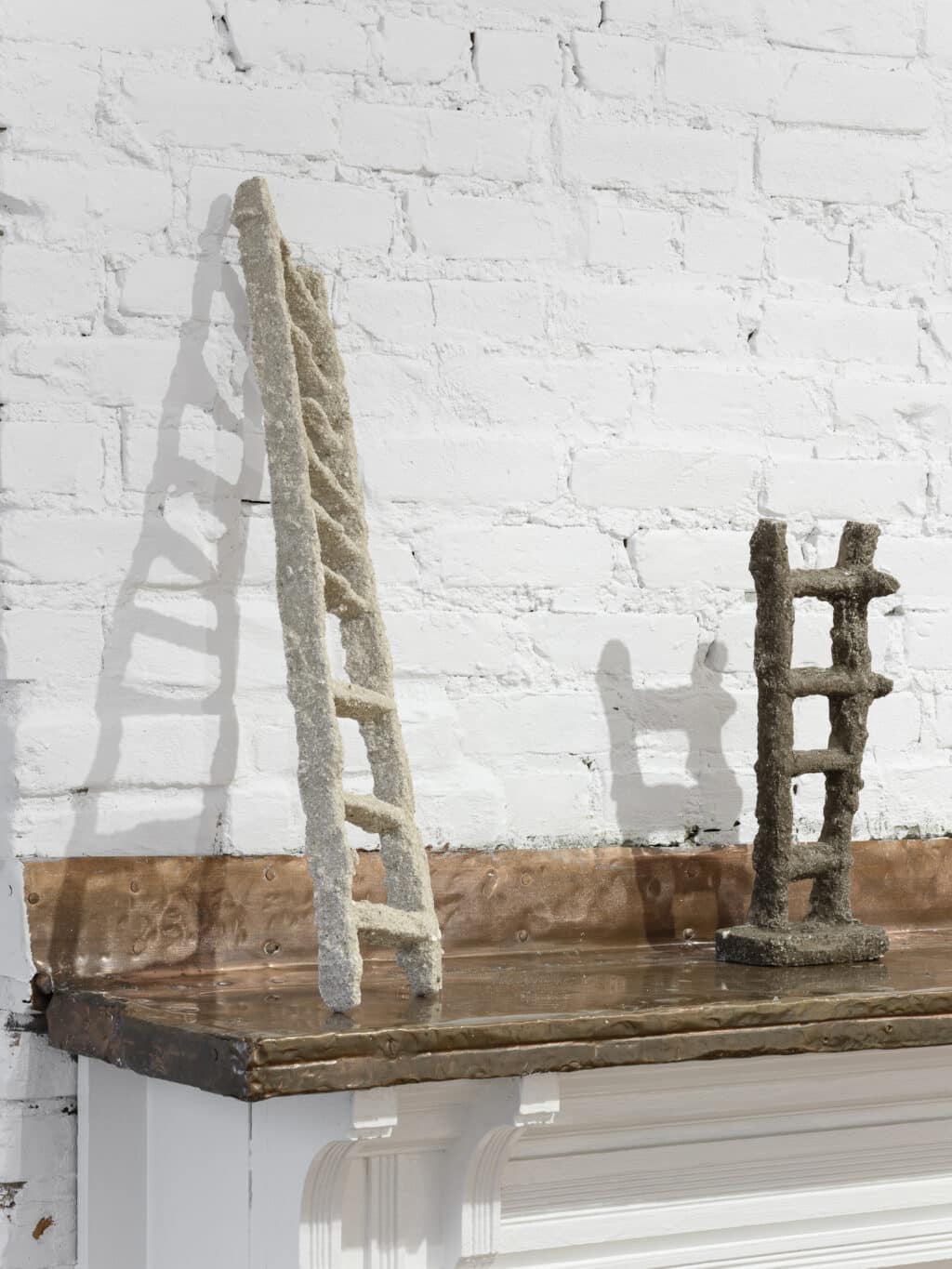William Corwin at Geary

WhiteHot Magazine | March 2021
Above:
Angled Ladder (Plaster), 2020
Plaster and sand
27½ x 6 x 2 in.
Sculptor, curator, writer, Will Corwin is accomplished at a number of things. His current show at Geary has to do with ladders–both as things and, more metaphorically, as objects indicative of ascension. They are made of several kinds of materials: iron, aluminum, bronze, plaster covered with dirt. Individually, the ladders have idiosyncratic touches; two may have been cast together; one has a disembodied hand grasping an upper rung; one has an incomplete tread. Cumulatively, the ladders enact an environment, in which their practical purpose falls away in the face of a more ethereal reading.
A major association we keep in mind is the biblical story of Jacob’s dream of a ladder rising from earth to heaven. The ladders are tools for moving upward, both in an actual and in an emblematic one. So the construction carries symbolic meaning. Corwin, who has worked on interesting art involving cooperation, such as a chess game between grandmasters playing with pieces made by the artist himself, is in this show returning to the creation of things. His move back to a more traditional consideration of the object is enriched by the metaphorical implications of the ladders, which may be simple objects but assume a function that is allegorical and high.
Double Ladder (2020), made of a greenish-gray aluminum, is a variation on a single theme. One shorter ladder is attached to the upper reaches of a longer one, supported by a flat pedestal. Even if we exclude, for a moment, the symbolic meaning of the object, the sculptural quality of the ladder comes through clearly, asserting a nearly abstract meaningfulness that distances Corwin’s audience from the work–its easy recognition as an image is not enough. Sculpture, just as much or even more than painting, doesn’t have to mean or describe as merely be. Those of us looking at the work can, to some extent, dissociate it from what it is meant to represent, separating the form from its realist function. Ladder with Broken Tread (2020), a tallish work made of bronze, has a rung that doesn’t fully extend to its vertical support. This small flaw also undermines its primary use as an aid to climbing. But so small a change results in a major change in our reading of the object. Thus, the artist emphasizes a visual reality some distance from its usual usage, turning it into a visionary work.
Ladder and Hand (2020) is a short ladder with a disembodied hand on the highest rung (a mass of some sort, difficult to recognize, occurs on one of the lower rungs). The hand of course humanizes the ladder, returning it to its practical function as a means to move upward. It is unusual but highly effective for Corwin to adjust or change in small ways the ladder with small alterations so that its Ur-form becomes transformed into something else, something larger. Hands are of course used to climb a ladder, but they are also the means by which the ladder is made. It is hard to tell whether the hand is a personal allusion or a reference in general to human contrivance. But the specifics of the ladder don’t matter so much as our appreciation of their non-practical function as a means to ascension. The double purpose of these objects is consistently made clear by the artist.
Interacting Ladders (2020) are two short ladders, roughly two feet high, with one leaning against the other at an angle. Again, it is hard not to expand the relationship between the two ladders–is this a portrayal in some way of human relations? It is hard to say, but the question itself is evocative in the way it leads us away from a realistic reading of the object to something grander and more ethereal. Corwin may, or may not, be consciously aiming for a metaphorical reading; I think he is in fact leaning toward the symbolic because he has deliberately chosen the ladder, necessarily with metaphysical properties, as his theme. We are now living in a time of artistic literalism, fueled by political concerns. Yet art’s strength usually comes from its implied meaning, not from its stated assertion. Corwin, who has done an excellent job in this show, understands that the implication of his efforts are at least as important as the literal meaning of the object. In this way, he returns art to a deeper consideration, in which the imagination holds true to the work in compelling ways.